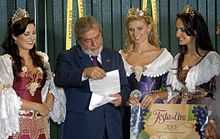Festa da Uva
| Festa da Uva Festa Nacional da Uva | |
|---|---|
 The Festa da Uva Queen and Princesses in Caxias do Sul with Brazilian President Lula | |
| Status | Active |
| Genre | Festival / Exhibition |
| Date(s) | 18 days in February and March in even-numbered years |
| Frequency | Biennial |
| Venue | Festa da Uva Pavilions |
| Location(s) | Caxias do Sul, Rio Grande do Sul |
| Coordinates | 29°08′46″S 51°11′54″W / 29.146110°S 51.198379°WCoordinates: 29°08′46″S 51°11′54″W / 29.146110°S 51.198379°W |
| Country | Brazil |
| Inaugurated | 1930[1] |
| Previous event | February 20 – March 9, 2014 |
| Next event | 2016 |
| Website | |
|
festanacionaldauva | |
The Festa da Uva or GrapeFest is a biennial celebration of the Italian heritage and culture in the city of Caxias do Sul, state of Rio Grande do Sul, in southern Brazil. The Festa da Uva is held every even-numbered year in February (i.e. held in February 2008). During the Festa da Uva, the Caxias do Sul pavilions host visitors mainly from South America, but also a few visitors from Europe, however this is very rare. Visitors taste cheese, grapes and various Brazilian wines. The large crowds draw many vendors that rent out booths to show the latest products that the southern gaúcho state has to offer.
The Festa also hosts parades that go through the city nightly. The Festa da Uva is also presided over by one Rainha (Queen) and two Princesas (Princesses) that must compete in a beauty pageant to be voted as such. A queen was first selected for the Festa da Uva in 1933. There was some minor controversy in 2000, when it was discovered that the Rainha (Queen) had been taking turns in the contest & appearances with her twin sister.
History
The Festa da Uva first started in 1931 as a harvest festival. The harvest in Brazil falls in February/March since the country is in the Southern Hemisphere. The Mayor of Caxias do Sul in 1931, Colonel Miguel Muratore gave organizers the necessary support to get the Festa off and running. The Festa went on hiatus from 1938–1949 because of the economic instability of the city and surrounding Italian Colonial region, due in part to the effects of World War II.
References
- ↑ Zottis, Alessandra. "FESTA DA UVA DE CAXIAS DO SUL/RS: A mémoria de uma festa através de seus cartazes". University of Caxias do Sul.